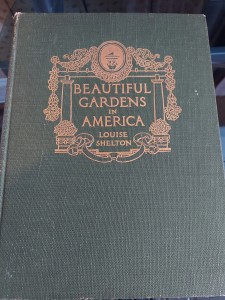 When the winter world resembles a gray, cold veil of sleeting tears, I turn to my library of garden books for psychological sustenance. One of my favorites is Beautiful Gardens in America, a book written in 1915 by Louise Shelton—1867-1934–of Morristown, NJ. I have the second edition, a hefty volume with a gold embossed title on a forest green cover.
When the winter world resembles a gray, cold veil of sleeting tears, I turn to my library of garden books for psychological sustenance. One of my favorites is Beautiful Gardens in America, a book written in 1915 by Louise Shelton—1867-1934–of Morristown, NJ. I have the second edition, a hefty volume with a gold embossed title on a forest green cover.
The book is a testament to Louise Shelton’s horticultural knowledge, her entrée to the gardens of affluent Americans, and, most of all, to her love of flowers. My edition features scores of detailed black and white garden photos, as well as a number of beautiful colored plates. The garden descriptions are broken out by states, so you can dip in and out of the book according to your geographical interests. It makes great bedtime reading.
Little information is available about Louise Shelton’s early years, but clearly she was well-off and well educated. Born just after the end of the Civil War, she lived most of her life in Morristown and is buried there, rather fittingly, in the Evergreen Cemetery. One of the more notable things about Louise Shelton was that she lived, gardened and was published as “Miss Shelton”, rather than “Mrs. Shelton”. In the record of the founding of the Morristown Garden Club, Louise Shelton is one of only two women identified as unmarried, and she was 46 at the time of the Club’s founding in 1913.
According to the Cultural Landscape Foundation, Shelton was an amateur gardener who designed her own landscape and used what she learned from that experience and the experiences of her fellow garden club members, in Morristown and elsewhere, as the basis of her first book: The Seasons of a Flower Garden: A Handbook for the Amateur. She went on to write Continuous Bloom in America, before publishing her best known work, Beautiful Gardens in America.
She was passionate about her subject. In the forward to Beautiful Gardens, she wrote, “Is there any life more real than the life in the garden for those who actually take part in its creation and nurture it carefully week by week and year by year?”
Morristown was and is an affluent suburb. In Shelton’s lifetime, the town was a major terminus for a commuter train line, nicknamed “the millionaire’s train,” which carried wealthy residents into Manhattan every day. The wives of some of those commuters, like Mrs. Charles Scribner, who was married to Shelton’s publisher, presided over large, impressive gardens. In an era when Americans, rich, poor and in-between, formed all kinds of associations, fraternal orders and special interest clubs, those women followed suit and organized the Morristown Garden Club.
It must be said that the well-heeled Morristown Garden Club members and those whose landscapes were profiled in Shelton’s book, may or may not have actually wielded trowels and spades. It was a time when aspirations, especially among the newly wealthy, were high and labor was cheap. Still, one of Shelton’s aims was to inspire the gardeners of the burgeoning middle class to improve their own home landscapes.
Louise Shelton was a champion of the uniquely American garden, influenced by and adapted from European models, but tailored to the specifics of the climates of various regions of the United States.
Climate is a constant theme in Shelton’s garden profiles, as is topography.
The gardens featured in the book, whether in Maine or in Florida, were composed of combinations of perennials, annuals, shrubs and trees put together within formal outlines and ornamented with all manner of statuary, fountains, pools, sundials, balustrades and pergolas. Some of them came from Europe; others were American-made knock-offs of European originals.
Clearly, as an indication of wealth and sophistication in places like Akron, Ohio, or Bar Harbor, Maine, nothing succeeded like a life-size statue of Poseidon in the middle of an ornamental water feature. To add a bit of balance, Shelton also celebrates landscapes that feature “an exquisite bit of semi-cultivated wildness”.
So what is the value of a book like Beautiful Gardens in America for today’s gardeners? Most of us do not have the ready supply of garden minions to keep our own “beautiful gardens” in tip-top shape, but like, Louse Shelton and her contemporaries; we have a constant need for garden inspiration.
Perhaps equally important, the vast majority of the gardens profiled in the book are either completely gone or substantially changed. Gardens are ephemeral, and often the only way we can learn from great landscapes of the past is through the pictures—especially the pictures—and descriptions in books like Shelton’s. In the middle of a cold winter and a frightening pandemic, a tour through great American gardens of the past is comforting. I recommend it.
Many booksellers carry either original editions of the three Shelton books or facsimiles. Try searching ABE Books at https://www.abebooks.com.
